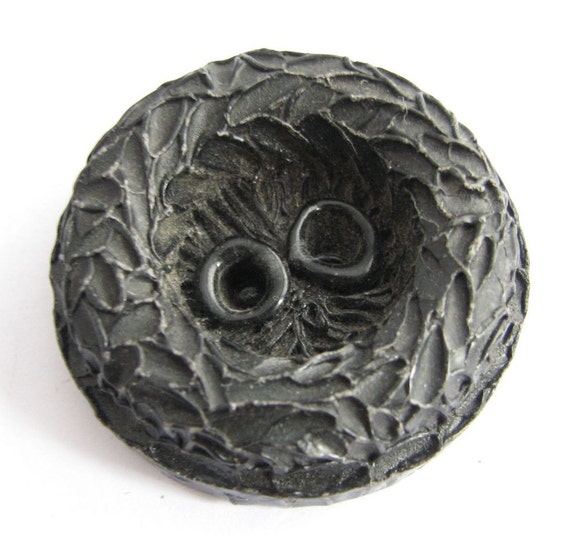 |
| A range of celluloid buttons from my original collection. Some have already sold out. |
Celluloid
- was the very first thermoplastic in history. It is actually made of cellulose, although mixed and exposed to other substances. It was invented as early as mid-nineteenth century, but it was most commonly used for button production between 1930s and 1950s. Other uses were, for example, in photography and movie films, toys, like dolls; table tennis balls and the already mentioned celluloid sheets used to destroy secret notes. |
| Celluloid buttons can preserve the dye really well. Look at these 1950s buttons. Some 1980s plastic buttons may have faded, but not these. |
How to identify celluloid
The most remarkable thing about celluloid buttons is the sound they make against each other. If you have ever played table tennis, you will identify it easily. If not, maybe you could try it? It is a valuable lesson.Another thing is its weight. Celluloid buttons are much lighter than acrylic or casein buttons. And you can actually perceive this difference just by taking it in your hand. No scales needed. This is an advantage when considering using large buttons in a sewing project. Also, you can identify them easily wth no need of extra paraphernalia, like when testing for bakelite, even outdoors in a street market.
Never use hot needle for testing celluloid! While this method may leave a horrible mark on most other materials, celluloid may burn spontaneously. Better take the table tennis lesson.
Also, celluloid is very brittle. It is easy to break, crack and chip. Sometimes this characteristic was even taken into account in the button design, so it would have a rough finish:
 |
| This celluloid button was designed in a way that any cracks will just add it extra roughness. This one is unused, so it looks perfect. |
 |
| Unfortunately, not all buttons are designed this way. If you see the image in full size, you will notice the cracks :( |
How to handle celluloid
It is very important to remember, that this material is highly inflammable. Not only does it catch fire instantly, completely destroying the piece, but also, it may go on fire when exposed to high temperatures (for example, keep them away from hot iron or oven).Because they are so easy to break and crack, they should not be stored together in a bag. When sending them overseas, I usually wrap them generously in bubble wrap, so that they do not touch one another. I would aso recommend removing them from a garment if you are planning to wash it in high temperatures, or before leaving it at dry cleaner's. If you have some really nice pieces sewn to your favourite dress or blazer, chances are they will get broken in the process. And never ever use a hot iron when the buttons are still sewn to a garment, also for your own safety. The same for dry cleaner's: they don't check all clothes, just press them as they are with the same industrial stuff. You may lose the buttons, and the drycleaner's shop along with them.
 |
| Plain caramel brown buttons, made of celluloid, on a vintage button card. These could be used in a coat, but remember to remove them before washing or leaving at dry cleaner's! |

No comments:
Post a Comment